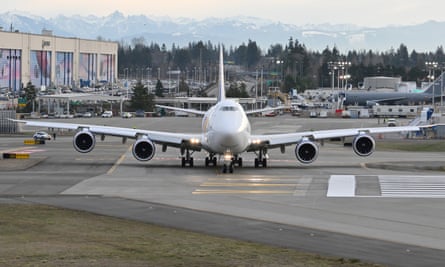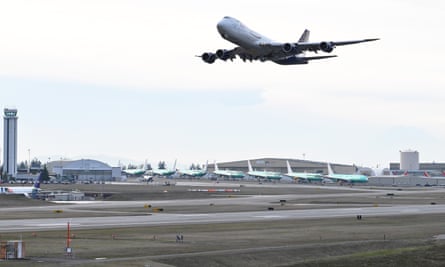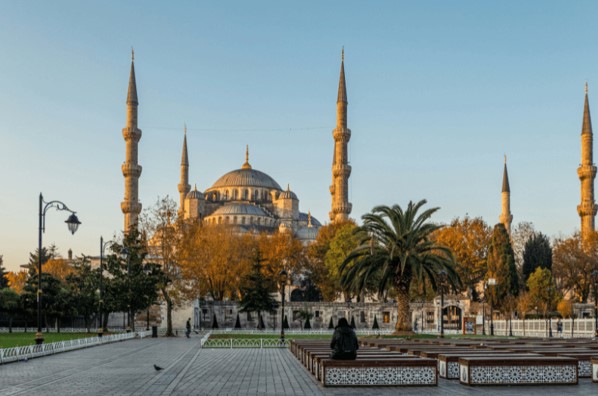By the time Lynn Rippelmeyer began work as a flight attendant on a Boeing 747 in 1972, the jumbo jet had already seized the public’s imagination for its immensity and the beauty of its lines, serving as the epitome of glamour in the skies.
“We had linen napkins and tablecloths, china and crystal vases with real flowers on a pedestal in first class. There was a seven-course meal. You got your prime rib carved right at your seat. It was quite something,” said the former TWA attendant.
In the early days, TWA maintained a bar and lounge up the spiral staircase and under the jumbo’s iconic hump. American Airlines installed a baby grand piano in first class on its 747 Luxury Liner.
Flying in the cheaper seats wasn’t so bad either. American boasted of an economy class lounge in the sky with “soft cushiony seats all around, in the middle is a stand-up bar”.
“It’s the most wonderful thing ever to happen to a coach passenger,” one of its ads said in 1971, a year after the 747 entered service. “In first class, you can reserve a table for four. Dine with friends as you would in a restaurant on the ground. Play cards.”
It might not have been quite so much fun for the staff. The food, which in economy included filet mignon, was “served by our stewardesses in their pretty new outfits”. Rippelmeyer was kitted out in TWA’s flight attendant uniform of go-go boots and hot pants. But not for long.
A decade later, the Illinois native had trained to become the world’s first female 747 pilot. But by then flying had begun its slide into packing passengers into ever shrinking seats and charging for drinks. By the mid-1980s she was funneling tourists across the Atlantic as a jumbo jet captain for a budget airline. No lounges or steaks.
But the “queen of the skies” never lost its allure.

The 747 outlasted predictions that it would be supplanted by supersonic aircraft and attempts by rival manufacturers to match its success until, after more than half a century and 1,574 aircraft built, the last jumbo jet was delivered to its new owner earlier this month. Perhaps fittingly, it was bought by a cargo airline, the glamour long since stripped from flying for most passengers.
But Rippelmeyer, who wrote a book about her experiences, Life Takes Wings, said no matter what a 747 was carrying, the charge never went out of piloting one.
“It’s like driving a limousine instead of a sports car,” she said.
“It’s the aeroplane that all the pilots wanted to fly. Because of its size, it’s so stable and you just feel so secure in it. And besides, it’s just a beautiful shape. When it’s coming in for landing, it almost looks like it’s going in slow motion. There’s the illusion that it’s floating.”
Nick Eades, the world’s most experienced 747 pilot, flew jumbos for 27,000 hours over 34 years for British Airways.
“I went on in 1987 and was struck by the sheer size of it. The pilots sat four floors up,” he said.
“It was a real pilot’s aeroplane. It was the probably the last aeroplane that was flown by the pilot and not a computer. It was a huge aeroplane but it flew so beautifully even in bad weather. It just was like an ocean liner in the sky. I’ve flown lots of different types of aeroplanes but when I started flying the jumbo, I just had a big silly grin across my face.”
At its launch, the jumbo was cutting-edge. It carried more than twice as many passengers as Boeing’s next largest plane and was more fuel-efficient, reducing the cost per seat and opening up the world to jet travel.
Pictures of the space shuttle piggybacking on the back of Nasa’s 747s only added to its glory.

Still, an economy return ticket from New York to London in the early 1970s was around $3,000 (£2,482) in today’s money, so passengers paid for the touches of luxury, even if the 747 played an important part in bringing prices down over time.
There were other downsides half a century ago. Rippelmeyer worked in first class because other female attendants didn’t want to deal with verbal harassment from male pilots.
“I grew up being teased so it didn’t bother me and I liked being up there. You’re seven miles above the earth and you get this 180-degree view. It’s just gorgeous and breathtaking,” she said.
When she wasn’t working, Rippelmeyer sat in the cockpit behind the engineer and became interested in how flight systems work. She took flying lessons and swiftly became hooked. But TWA didn’t hire female pilots so she didn’t see it as a career option.
“Then they decided women could fly aeroplanes after all, so I got a job with TWA as a flight engineer. I became the first woman to go from flight attendant to pilot at an airline, and that was 1978,” she said.
But the industry took a downturn so Rippelmeyer joined a company flying cargo as a first officer.
“That’s where the chief pilot said: ‘How would you like to be the first woman to fly a 747?’ Some of the pilots used to say women just don’t have what it takes emotionally, psychologically, physically, and then there’s that time of the month when they really shouldn’t even leave the house. They really believed what they were doing was more than a woman could handle,” she said.
“So that’s what I told this chief pilot. He looks at me: ‘Girl, it’s hydraulics. I’ll show you.’”
Rippelmeyer qualified to fly jumbos and joined a low-cost airline, People Express, which took passengers from New York to London for a relatively paltry $149 (£123).
“I’m not sure there was the glamour at the People Express aeroplanes but it did allow people to travel that hadn’t before,“ she said.
Rippelmeyer was the first woman to captain a jumbo jet across the Atlantic. She landed at London’s Gatwick airport in July 1984 to an enthusiastic reception from the British press and later in the year was honoured at a “women of the year” ceremony in the UK.
By then, the 747 had already been in service longer than some expected amid predictions that supersonic travel would take over in the 1980s. But the only other plane to challenge the jumbo jet’s iconic status, the Concorde, never proved to be commercially viable and ceased flying 20 years ago.
Other rivals tried to usurp the jumbo. Lockheed launched the TriStar but it was little mourned when production stopped 12 years later. Then came the giant Airbus A380 in 2007. But the plane, which Rippelmeyer likened to “a double-decker bus with wings”, lacked the elegance and sophistication of the jumbo jet. It ceased production two years ago, having sold a fraction of the number of 747s.
Eades, author of a book Still Improving: Becoming the World’s Most Experienced 747 Captain, said Boeing helped keep competition at bay by improving each variation of the plane until it reached what he regards as the best of them, the 747-400, which outsold all other versions.
“It’s like an orchestra when suddenly all the musicians play in perfect harmony. And that was the 400,” he said.
Nonetheless, time took its toll on the 747 as lighter planes with more efficient engines proved far cheaper to run.
Yet the jumbo jet still has the power to awe. Kelsey Hughes, a 747 pilot who flies cargo and passengers including major sports teams, said that even today people are awestruck by the plane.
“It’s like hanging out with a celebrity all the time. No matter what other plane I’ve flown, people never take photos of it. But this plane, there’s a lot of places I go and there will be multiple people standing there taking photos or selfies with it in the background. It still has them saying, ‘wow’,” he said.
John Travolta, actor and 747 pilot, was among those on hand to bid farewell as the final jumbo jet left the assembly plant just outside Seattle.
“Even when you understand the science behind flight, there’s nothing like seeing a 747 take flight to remind you that there’s also magic here,” he said.
The jumbo jet won’t be disappearing from the skies. Some passenger airlines, such as Lufthansa, still fly it. The White House uses a modified version for Air Force One. And the final plane off the production line is going to Atlas Air, which operates the largest 747 fleet in the world.




More Stories
A Golden Week for China Air Travel May Stem Drop in Oil Prices
Why is flying in the summer so expensive? Cheap flights can be scarce
Brace yourself for a summer of air travel hell